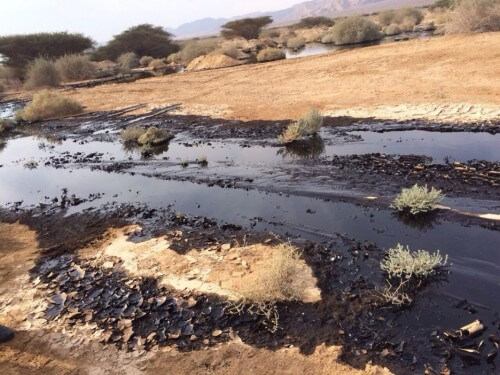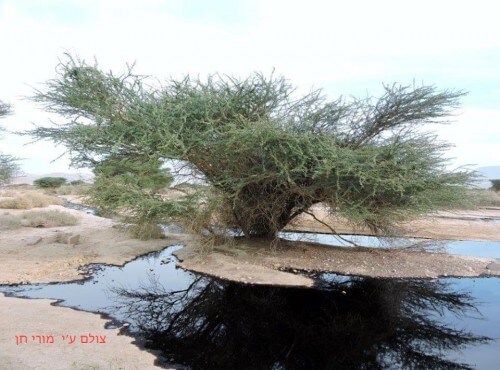Ein Evrona Reserve hosts a population of Negev deer, a grove of palm trees and rare desert plants. Now everything is in danger

The Evrona reserve extends from the north of the (northern) salt ponds to the vicinity of the new (and unnecessary) airport that is being built between the Jordanian border in the east and Highway 90 in the west.
The reserve contains one of the most densely populated Shit groves in the Arava and Negev, which supports a healthy population of Negev deer. In the eastern part of the reserve, there is a brackish strip with unique vegetation such as: Yamloch, Haga, Yanbot, Ochem, and more. There are also a few date palms, perhaps a remnant of an ancient settlement, and a well (Ein Evrona) that was recently renewed and filled with water.
The richness of the vegetation and the proximity to water sources (in the agricultural fields) attracts to the area thousands of birds that pass through in the autumn and spring migration. As a continuation of a well from the Arab period and an agricultural farm that was watered by chain wells (pogrots), an agricultural farm was developed in the 80s to the south of the reserve. The vegetation, the well and agriculture rely on aqua (brackish water) close to the ground which for many years supplied Eilat with water.
All the uniqueness and beauty described is in danger due to the criminal negligence of criminals, since Eilat stinks and this time there is no stench from the open garbage containers nor the cattle rustler. The stench is an oil stench as a result of a break in the Katsa pipeline a little south of the Ora well. Following the rupture, thousands of cubic meters of crude oil flowed eastward. Because of the north wind, the stench clouds reached Aqaba and from there dozens of casualties are reported.
In the first stage, road 90 was flooded and closed, the oil continued to flow and created huge puddles in the Evrona reserve. Stream channels where seasonal floods flow were filled with the black pulp. The gruesome photos are published in all media so that even those who are not in the know can understand the magnitude of the disaster. The immediate harm is to the animals caught in the black pulp, even those who "just crossed" the puddles carry the poison and will eventually die.
The immediate damage to the vegetation close to the flow channels and the black puddles will show that in the coming days the plants will dry out, later on plants far from the pulp will dry out as the roots of some of the desert plants extend over a large area. Later the toxic pulp will seep deep into the ground and rains will deepen the seepage until the oil reaches the water from which most of the acacia trees draw their water, the acacia trees will dry up.

Deeper is the place where the oil will reach, they pump water to Eilat and the surrounding settlements and it will be necessary to purify dozens of wells to allow the continuation of the water supply.
The area that is still green today will turn yellow and black and the deer and other creatures will become extinct. Migratory birds that relied on the green forest will remain without shelter and food. The wells of the chain (the slack ones) some of which had moisture will be filled with the black sewage, my colleague and I have led trips to the area and we probably won't be able to do that in the foreseeable future.
The people of the Ministry of the Environment and the Authority are already in the field in attempts to stop the spread of the disaster, later work will begin to remove the oil and purify the land which will last for many years and prevent only a small part of the damage. All this because of criminal negligence.
The police are obliged to charge criminals. The Ministry of Environmental Protection and the Parks Authority, the Municipality of Eilat and the Eilot Regional Council, tourism organizations and operators of desert tours (in jeeps),
Mekorot (water supply) company and all water users. All of them together and each one individually must file a tort claim against the managers of Katsa, the employees who caused the damage and anyone involved in the environmental crime, charging the company and those responsible on its behalf to bear all the costs of cleaning up the waste water, a heavy penalty for the pollution of the soil and water sources, heavy prison sentences and high financial fines.
In this way, it may be possible to mitigate some of the damage and clean up a little of the pollution, all of this should be done in a quick and abbreviated procedure, so that the criminals will be punished immediately and so that those who transgress by force will see and be seen.

5 תגובות
A bit about the oil pipeline. Very worth reading
https://www.facebook.com/Eishton.Blog/posts/642751572496881
Honorable Dr.
First, indeed an unpleasant and clearly unnecessary event. It is still very early to eulogize the reserve and its values and its population will be victims and each of them is unnecessary, but we need to look at its presence and not at slogans. Because there is something to do.
The crude oil does not seep and will not interfere with the fugaras. Also because it is very heavy and very fatty. It is not a desal or a distillate, but a very oily and indeed very fragrant liquid.
In the outer layer of the soil there are billions of bacteria that knew how to deal with this hydrocarbon pollution in most cases. Especially after most of the contaminated area, approximately 80 dunams, will be cleaned as much as possible of surface runoff, pools of crude oil and a few emulsions that were created as a result of the small flood to our happiness.
The area will not turn black and nature knows how to recover, it has already proven this, when it is assisted in a scientific way and with constant research. The 'soil purification' works will not last for years but a few weeks, the contaminated soil will undergo biological and other treatments, at the nearest waste site of the council or at facilities further away.... And the remains of a sign found during the 'big' treatment will be treated on a spot basis as they are found.
Was there damage? Definitely. A lot of unnecessary damage. Is it a disaster that will irreversibly pollute the land and water and kill everything that comes into contact with it? no and no. Neither is there nor was there any flow into the Bay of Eilat in view of the topography, the correct preparation and with the luck that the flood was 'small'.
I keep saying: it's a shame that it happened, the worst thing that happened is that proper planning and enforcement should be taken care of so that it doesn't happen again. Not in the past and not anywhere else. Still, it is treated correctly and in the near future we will see results. Of course there is no point in obituaries.
Bibi, he is also the Minister of Environmental Protection. But not the Prime Minister, and not anyone will take responsibility! I recommend to the members of the government to listen to Natan Salor's poem: Boy with a monkey.
Right, sue them urgently
I forgot to add that:
If and in the near future,
before they have time to empty the pulp,
A flood will come...
The nauseating pulp will arrive in the Gulf of Eilat
And cause more pollution...